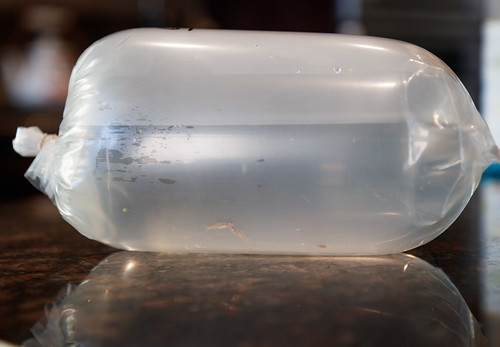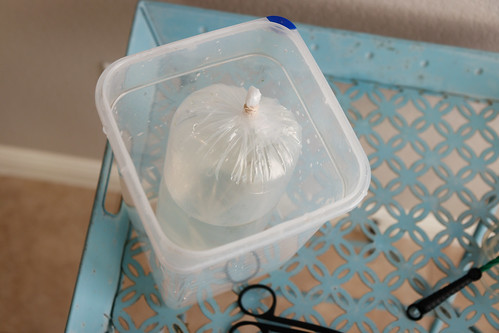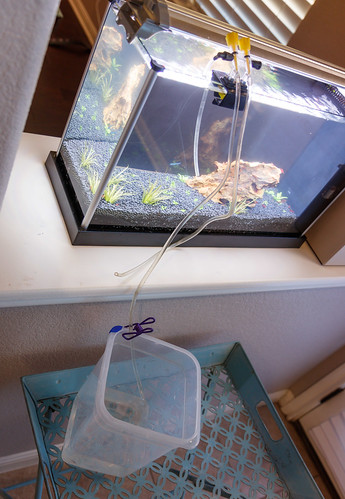Recently, we added a few newcomers to our Spec V aquarium. Uno, our lone green neon, has been the sole fish occupant for the past year. I just bought new fish for the tank – 6 Phoenix Rasbora. Putting new fish in an aquarium isn’t hard, but there are a few tips to get them acclimated.
Travel and Tank Preparation:
Fish are often sold for transport in bags. My fish store puts pressurized air so that the bag is tight. The bag ends up in the shape of a cylinder. It’s good to plan ahead and have a suitably sized box or container to hold the bag steady and restrain it from rolling around during travel back to your home.
It’s good to try and maintain a temperature environment close to what the fish will be kept at – somewhere in the mid 70°F range. If you know the travel temps are going to be outside this range (like a hot car) consider transporting the fish in an insulated cooler. This will slow down the heat transfer and keep them comfy for longer.
You might ask the fish store what tank temperature they maintain for the fish purchased. You won’t necessarily need to change your tank to match, but it’s good information that may play into how you acclimate them.
As early as possible, turn off your pressurized CO2 system (if you have one). Purchased fish are not used to CO2 so you want to give them the first day to just deal with the new water and environment and not also deal with higher CO2 levels.
New fish may be skittish and will want to hide. Turn off your light for the day to ease the stress. If you have a planted tank with bright lights, the light intensity is probably much higher than what they are used to in the store.
Out of Bag and Into a Container
Drip acclimation is much easier if you get the fish out of the store bag and into a tupperware container. I have a good one that is about a gallon and has straight sides (not round). Straight sides are better as it is easier to net a fish in a straight side container (compared to round).
I got this tip somewhere on how to transfer fish from a bag to a container. First, set the bag into the container you want to transfer them into.
Then, using a pair of scissors, cut down the side starting at the top. slice all the way down to the bottom. If you need to, make another cut down the opposite side.
At that point all the water has spilled out the sides and you have a bag floating in water. Gently coerce the fish out of the bag remnants and remove the bag.
Drip Acclimation:
I use drip acclimation to slowly add aquarium water to the fish container. The theory is that as you slowly add your tank water to the fish container, you begin to close the gap in water parameter differences between your tank water and the store aquarium water. The big parameter that you are trying to match is temperature, but you are also bring all other parameters closer to matching. This includes, PH level, hardness, oxygen saturation, etc.
To setup and start drip acclimation, you need some tubing to siphon water from your tank into the container where the fish are hanging out. I just use standard aquarium airline tubing.
You need a way to slow down the siphon flow of water from your aquarium, through the tubing, to your temporary fish container. I’ve heard you can just tie a loose knot in the air-line, but a valve of sorts would give you better control. I use this plastic two-way air gang valve and it works fine. If I had it to do over, I’d get this stainless gang valve
.
For the siphon to work you need to get the temporary container lower than the aquarium. I set it on a little stand. Then get your tubing and valve setup. You may have a better way to start a siphon – I just suck to get the tube full of water. With careful timing and a thumb over the end, you should be able to get it started without a mouth full of fish water. Should.
Once the siphon is started, adjust the flow so that you get a quick drip rate. Keep watch on the water levels – over time your temporary fish container may get too full. If this happens, just scoop some water out and discard. Likewise, on a small aquarium (like the Spec V or Spec III) you might have to add a bit of makeup water to the aquarium as you go.
I try to time it so that the drip acclimation takes about an hour. No need for it to take longer than this. Over that hour, try to add at least half of the water volume as aquarium. That is to say if you start with two quarts of water from the fish bag, add at least a quart of aquarium tank water.
Once the drip acclimation phase is over, it’s time to move the fish into the tank. Ideally you will just move the fish and leave the fish store’s water behind, so use a good fish net to scoop the fish out and gently place them in their new home.
Fish After-Care:
Not much to do other than make their first night low stress. As I mentioned before, just leave the lights off for their first day. The dim or dark conditions help give them a sensation of being hidden and will make them feel safe.
You can feed them but no real need to do so the first evening.
For those with pressurized CO2 systems, watch carefully how they react the following day when the CO2 comes on. Watch for signs they are overwhelmed by CO2 (gasping at the top, swimming at the very bottom, ‘drunk’ swimming behavior). If you see any of these signs, shut off the CO2 and consider performing a large water change (to quickly drop the dissolved CO2 down).
If you are not going to be home to observe when the CO2 comes on, you might play it safe and turn down the CO2 bubble rate for a few days and adjust back up slowly over a week so the new fish can adjust.
Alternate Method – Plop and Drop:
I like drip acclimation for new fish and that’s what I’m presenting as the preferred method, particularly in the scenario above where fish are coming from a local store. However, situations may call for a quicker means of getting fish into the aquarium.
What if you are traveling a long distance with the fish? Even more-so, what if the fish are being shipped in the mail? I have never done this, but some people without access to a well stocked fish store may have mail order as the only option.
After their long journey, the fish will be sitting in water that is more than likely high in ammonia (from the fish’s own waste) and low in oxygen. The theory of many people that in this situation, it is best not to lengthen time in this putrid water through a long drip acclimation process. Instead, knowing that the water in the tank is vastly better quality than what the fish are sitting in, just get them into their new home quickly.
The method is affectionately called “plop n’ drop”. As in plop them out of that dirty water and drop them in the tank.
I think either method can work. Whichever you choose, make it a priority to try and match the temperatures as close as possible. Temperature shock is probably the biggest risk to newly added fish.
How about Acclimating Fish in a Saltwater Tank?
The information in this article generally applies to all fish, but I have a separate article for adding fish to a saltwater tank. It has some details that are specific to a marine setup and is part of my EVO 13.5 series.












Great tips.
I recently bought a Spec V to home some White Clouds and Neons, planted with plenty of driftwood.
I use a variation on the drip method.
Instead of tupperware I used one of those shallow thin plastic containers used for takeaway food. I empty away most of the aquarium shop water from the bag then empty the fish into the container with just enough water to cover and let the fish swim freely. Then I float the container in the Spec for 45-60 minutes, adding a small amount of aquarium water every five minutes. The small dosing cap from a bottle of Fluval Cycle or Aqua plus is perfect for this. I then just dip one end of the container below the water line and slow remove.
The very thin plastic of the food container allows for efficient equalisation of temperature when floating in the tank.
Gentle and stress free.
Nice method. It’s not rocket science, as they say. Multiple ways to gently get them into their new home.